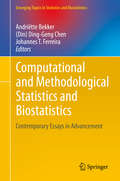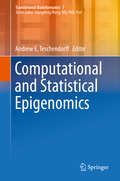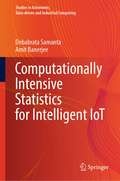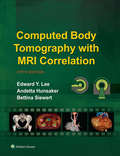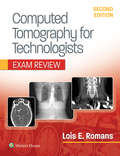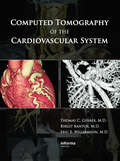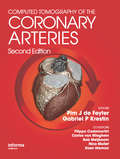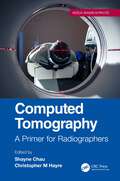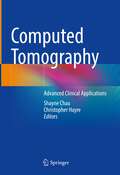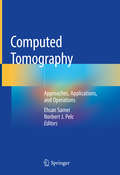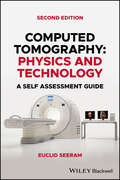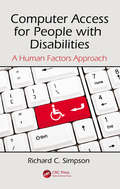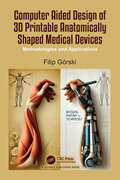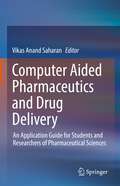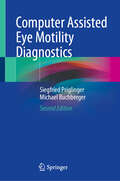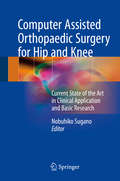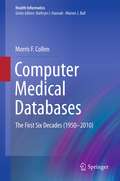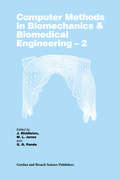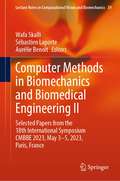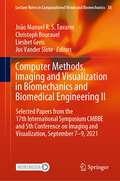- Table View
- List View
Computational and Methodological Statistics and Biostatistics: Contemporary Essays in Advancement (Emerging Topics in Statistics and Biostatistics)
by Din Ding-Geng Chen Andriëtte Bekker Johannes T. FerreiraIn the statistical domain, certain topics have received considerable attention during the last decade or so, necessitated by the growth and evolution of data and theoretical challenges. This growth has invariably been accompanied by computational advancement, which has presented end users as well as researchers with the necessary opportunities to handle data and implement modelling solutions for statistical purposes.Showcasing the interplay among a variety of disciplines, this book offers pioneering theoretical and applied solutions to practice-oriented problems. As a carefully curated collection of prominent international thought leaders, it fosters collaboration between statisticians and biostatisticians and provides an array of thought processes and tools to its readers. The book thereby creates an understanding and appreciation of recent developments as well as an implementation of these contributions within the broader framework of both academia and industry.Computational and Methodological Statistics and Biostatistics is composed of three main themes:• Recent developments in theory and applications of statistical distributions;• Recent developments in supervised and unsupervised modelling;• Recent developments in biostatistics;and also features programming code and accompanying algorithms to enable readers to replicate and implement methodologies. Therefore, this monograph provides a concise point of reference for a variety of current trends and topics within the statistical domain. With interdisciplinary appeal, it will be useful to researchers, graduate students, and practitioners in statistics, biostatistics, clinical methodology, geology, data science, and actuarial science, amongst others.
Computational and Statistical Epigenomics (Translational Bioinformatics #7)
by Andrew E. TeschendorffThis book introduces the reader to modern computational and statistical tools for translational epigenomics research. Over the last decade, epigenomics has emerged as a key area of molecular biology, epidemiology and genome medicine. Epigenomics not only offers us a deeper understanding of fundamental cellular biology, but also provides us with the basis for an improved understanding and management of complex diseases. From novel biomarkers for risk prediction, early detection, diagnosis and prognosis of common diseases, to novel therapeutic strategies, epigenomics is set to play a key role in the personalized medicine of the future. In this book we introduce the reader to some of the most important computational and statistical methods for analyzing epigenomic data, with a special focus on DNA methylation. Topics include normalization, correction for cellular heterogeneity, batch effects, clustering, supervised analysis and integrative methods for systems epigenomics. This book will be of interest to students and researchers in bioinformatics, biostatistics, biologists and clinicians alike. Dr. Andrew E. Teschendorff is Head of the Computational Systems Genomics Lab at the CAS-MPG Partner Institute for Computational Biology, Shanghai, China, as well as an Honorary Research Fellow at the UCL Cancer Institute, University College London, UK.
Computationally Intensive Statistics for Intelligent IoT (Studies in Autonomic, Data-driven and Industrial Computing)
by Amit Banerjee Debabrata SamantaThe book covers computational statistics, its methodologies and applications for IoT device. It includes the details in the areas of computational arithmetic and its influence on computational statistics, numerical algorithms in statistical application software, basics of computer systems, statistical techniques, linear algebra and its role in optimization techniques, evolution of optimization techniques, optimal utilization of computer resources, and statistical graphics role in data analysis. It also explores computational inferencing and computer model's role in design of experiments, Bayesian analysis, survival analysis and data mining in computational statistics.
Computed Body Tomography with MRI Correlation
by Edward Y. Lee Andetta Hunsaker Bettina SiewertAuthoritative, clinically oriented, and unique in the field,Computed Body Tomography with MRI Correlation, 5th Editionis your one-stop reference for current information on CT and MRI in all aspects of adult and pediatric congenital and acquired disorders. This comprehensive text uses an easy-to-navigate format to deliver complete, well-illustrated coverage of the most current CT and MRI techniques for thorax, abdomen, pelvis and musculoskeletal systems in both adult and pediatric populations. The fully revised 5th Edition is a complete reference for residents, fellows, and attending radiologists, as well as clinicians in other specialties who are interested in CT and MRI evaluation of both common and less common disorders encountered in daily practice.
Computed Tomography for Technologists: A Comprehensive Text
by Lois RomansPublisher's Note: Products purchased from 3rd Party sellers are not guaranteed by the Publisher for quality, authenticity, or access to any online entitlements included with the product. Covering only what CT technologists need to know, this all-in-one solution helps students develop the knowledge and decision-making skills they need for clinical practice while preparing them for the ARRT registry exam. Organized around the three major ARRT content categories (physics and instrumentation, patient care, and imaging procedures), the fully updated 2nd Edition takes an easy-to-understand approach that combines real-world scenarios, and proven pedagogy to help students master the content of the course.
Computed Tomography for Technologists: A Comprehensive Text
by Lois RomansPublisher's Note: Products purchased from 3rd Party sellers are not guaranteed by the Publisher for quality, authenticity, or access to any online entitlements included with the product. Computed Tomography for Technologists: Exam Review, Second Edition, is intended to be used as a companion to Computed Tomography for Technologists: A Comprehensive Text, Second Edition, and as a review of computed tomography on its own. This is an excellent resource for students preparing to take the advanced level certification exam offered by The American Registry of Radiologic Technologists (ARRT).
Computed Tomography of the Cardiovascular System
by Birgit Kantor Thomas C Gerber Eric E WilliamsonComputed tomography of the heart and cardiovascular system continues to show an impressive and tremendously successful development. Technical improvements translate into new applications and enhanced diagnostic accuracy and the new diagnostic opportunities may potentially be beneficial for many individuals with known or suspected cardiovascular dis
Computed Tomography of the Coronary Arteries
by Pim J. De Feyter G. P. Gabriel KrestinUpdated to reflect the notable advances in cardiac computed tomography (CT) imaging, the Second Edition of the best-selling Computed Tomography of the Coronary Arteries provides cardiologists and radiologists with a practical text that explains the basic principles and applications of CT. Written by renowned international experts in the field, this
Computed Tomography: A Primer for Radiographers (Medical Imaging in Practice)
by Chau ShayneThis book acts as a primer for radiographers upon performing computed tomography (CT) examinations. The focus resides in radiation physics, radiobiology, anatomy, imaging protocols and image evaluation. It seeks to provide readers insight into the practical and innovative approaches within CT, backed up with key literature and examples in practice. Recent innovations and the importance of new technology to acquire enhanced quality remain a focal point. These are essential in understanding the importance of dose optimization, patient anatomy and common pathology observed. Patient care will remain central in this book, supported with a dedicated chapter discussing effective communication, patient education, informed consent, coupled with the assessment of laboratory results and vital signs. The editors draw from recent publications and clinical expertise, supported with the growing trend of technological advances utilized within the CT environment. Critically, this volume focuses on the role of CT for an array of audiences but, more specifically, undergraduate and postgraduate radiographers worldwide.
Computed Tomography: Advanced Clinical Applications
by Shayne Chau Christopher HayreThis edited volume will focus on the advanced elements of computed tomography for an array of audiences, but more specifically, to undergraduate and postgraduate radiographers or CT technologists. This book will draw on the international expertise of advanced topics in CT. Typically, CT practices and approaches differ between hospital sites and workplace environments. As there are currently no universally accepted approaches, the reader can use this book to develop local imaging protocols with adjustments made for patients, the type of scanner and the radiologists’ or physicians’ preferences. Editors anticipate this to remain a key text for undergraduate and postgraduate radiography and CT students as it incorporates a holistic view of the profession whilst identifying advanced knowledge and understanding pertinent to CT practice. This is not a text on CT physics and imaging protocols alone but on the application and potential for such advanced techniques within the computed tomography field. The text, which includes most relevant technical and pathophysiological premises, also articulates learning points and pitfalls. Throughout the text, there is also an emphasis on image evaluation, with guidance on the recognition of normal, benign, and malignant pathologies and clear instruction on learning points and pitfalls. Given the increasing recognition of advanced scope of practice and professional capabilities in the field of medical radiation science, a focus on CT imaging within emergency settings, interventional environments and forensic imaging is portrayed. It is intended that this text will enhance and offer original discussions surrounding the interconnectivity of the technology, sciences research, and patient care in CT.
Computed Tomography: Approaches, Applications, and Operations
by Ehsan Samei Norbert J. PelcThis book offers a comprehensive and topical depiction of advances in CT imaging. CT has become a leading medical imaging modality, thanks to its superb spatial and temporal resolution to depict anatomical details. New advances have further extended the technology to provide physiological information, enabling a wide and expanding range of clinical applications. The text covers the latest advancements in CT technology and clinical applications for a variety of CT types and imaging methods. The content is presented in seven parts to offer a structure across a board coverage of CT: CT Systems, CT Performance, CT Practice, Spectral CT, Quantitative CT, Functional CT, and Special Purpose CT. Each contain chapters written by leading experts in the field, covering CT hardware and software innovations, CT operation, CT performance characterization, functional and quantitative applications, and CT systems devised for specific anatomical applications. This book is an ideal resource for practitioners of CT applications in medicine, including physicians, trainees, engineers, and scientists.
Computed Tomography: Physics and Technology. A Self Assessment Guide
by Euclid SeeramCOMPUTED TOMOGRAPHY: PHYSICS AND TECHNOLOGY In the newly updated second edition of Computed Tomography: Physics and Technology A Self Assessment Guide, distinguished computed tomography (CT) educator Euclid Seeram delivers a completely revised and expanded collection of multiple-choice questions covering all relevant technological advances, including the use of artificial intelligence, in the field of CT. In the book, readers will find a focused emphasis on physics and technology — an area where students of this discipline have traditionally struggled. The questions are presented in a format similar to those found on the certification examinations of the American Registry of Radiologic Technologists (ARRT), the Canadian Association of Medical Radiation Technologists (CAMRT), and other professional medical imaging organizations around the world. The author has also included true-false questions, short answer questions, and relevant learning outcomes to aid students in their study of the subject. Readers will also find brief notes on: An introduction to computed tomography, including an overview of the field and a historical perspective Digital image processing and the physics of computed tomography Data acquisition principles and technology and image reconstruction fundamentals Deep learning image reconstruction, the major equipment components of a computed tomography scanner, and image post-processing and visualization Multislice CT: Principles and Technology Image quality considerations CT Dosimetry and dose optimization strategies Quality control Perfect for radiological technology and diagnostic radiography students and practitioners, Computed Tomography: Physics and Technology A Self Assessment Guide, will also earn a place in the libraries of biomedical engineering students and radiology residents in training.
Computer Access for People with Disabilities: A Human Factors Approach (Rehabilitation Science in Practice Series)
by Richard C. SimpsonIncorporating Compass Computer Access Assessment software, Computer Access for People with Disabilities: A Human Factors Approach provides the information clinicians need to know in order to provide effective alternative computer access solutions to individuals with disabilities. This book presents technology for individuals with physical, cognitive, and sensory impairments, and for older adults. The text covers text entry devices, pointing devices, switch access, automatic speech recognition, and web accessibility. The book draws on research from the fields of rehabilitation engineering, occupational therapy, and human-computer interaction (HCI) and emphasizes fundamental concepts and principles that remain true regardless of which specific operating system or product is being used.
Computer Aided Design of 3D Printable Anatomically Shaped Medical Devices: Methodologies and Applications
by Filip Gorski"Computer Aided Design of 3D Printable Anatomically Shaped Medical Devices: Methodologies and Applications" presents a comprehensive framework for designing 3D printable medical devices tailored to individual anatomies. Bridging engineering and medicine, the book guides readers through advanced CAD techniques, anatomical data acquisition (via 3D scanning and imaging), and additive manufacturing processes, presenting mostly results of author's own and co-authored research. Emphasizing efficiency, customization, and real-world applications, it showcases methodologies developed in collaboration with medical professionals for orthopedic devices, surgical aids, and prosthetics. Case studies offer insights into practical uses, demonstrating how these innovations enhance patient care and surgical outcomes through personalized, accessible solutions.
Computer Aided Pharmaceutics and Drug Delivery: An Application Guide for Students and Researchers of Pharmaceutical Sciences
by Vikas Anand SaharanThis book examines the role of computer-assisted techniques for discovering, designing, optimizing and manufacturing new, effective, and safe pharmaceutical formulations and drug delivery systems. The book discusses computational approaches, statistical modeling and molecular modeling for the development and safe delivery of drugs in humans. The application of concepts of QbD (Quality by Design), DoE (Design of Experiments), artificial intelligence and in silico pharmacokinetic assessment/simulation have been made a lot easier with the help of commercial software and expert systems. This title provides in-depth knowledge of such useful software with illustrations from the latest researches. The book also fills in the gap between pharmaceutics and molecular modeling at micro, meso and maro scale by covering topics such as advancements in computer-aided Drug Design (CADD), drug-polymer interactions in drug delivery systems, molecular modeling of nanoparticles and pharmaceutics/bioinformatics. This book provides abundant applications of computers in formulation designing and characterization are provided as examples, case studies and illustrations. Short reviews of software, databases and expert systems have also been added to culminate the interest of readers for novel applications in formulation development and drug delivery. Computer-aided pharmaceutics and drug delivery is an authoritative reference source for all the latest scholarly update on emerging developments in computed assisted techniques for drug designing and development. The book is ideally designed for pharmacists, medical practitioners, students and researchers.
Computer Aided Surgery
by Masakatsu G. FujieThis book presents the latest research advances in the theory, design, control, and application of robot systems intended for a variety of purposes such as manipulation, manufacturing, automation, surgery, locomotion, and biomechanics. Several chapters deal with fundamental kinematics in nature, including synthesis, calibration, redundancy, force control, dexterity, inverse and forward kinematics, kinematic singularities, and over-constrained systems. This book is a compilation of the extended versions of the very best papers selected from the many that were presented at the Asian Conference on Computer-Aided Surgery held September 16-18, 2013, in Tokyo, Japan (ACCAS 2013).
Computer Applications in Nutrition & Dietetics: An Annotated Bibliography
by John OrtaFirst Published in 1988. Routledge is an imprint of Taylor & Francis, an informa company.
Computer Assisted Eye Motility Diagnostics
by Siegfried Priglinger Michael BuchbergerThis book introduces a unique computer system for predicting the outcome of strabismus surgeries. Diagnostic data of individual surgical cases, related diagnosis and treatments are incorporated into a well-designed, clinically applicable simulation model. Based on a biomechanical model of the human eye, a new way of interactive, virtual eye muscle surgery is proposed, which enables the prediction of surgical outcomes based on objective, anatomically related and measured data. Additionally, a realistic three-dimensional visualization of the human eyes and their muscles supports detailed evaluation and meaningful interpretation of eye motility disorders. This software system is neither intended to replace common clinical diagnostics, nor surgical expertise. It should improve education, training, and the accuracy of clinical decisions due to the possibility of simulation, graphical representation and comparison of different eye motility disorders. Computer Assisted Eye Motility Diagnostics, 2nd Edition brings education in the field of ophthalmology to a new dimension – for the basics of the function of the oculomotor control to deep inside knowledge for dealing with complex eye motility disorders and to create motivation and interest in strabology through learning by doing.
Computer Assisted Orthopaedic Surgery for Hip and Knee: Current State Of The Art In Clinical Application And Basic Research
by Nobuhiko SuganoThis book focuses on two major areas in the field of computer assisted orthopaedic surgery (CAOS): hip and knee surgery.It reviews the current clinical status of the various CAOS tools for hip and knee arthroplasty, osteotomy, ligament reconstruction, spine surgery, trauma surgery, and tumour surgery that have become available in recent years and discusses future applications based on fundamental research and continuously developing computer technology / devices. Computer Assisted Orthopaedic Surgery for Hip and Knee highlights three areas – total knee arthroplasty (TKA); total hip arthroplasty (THA) and hip osteotomy; and statistical shape modelling. It is a valuable resource for orthopaedic surgeons, clinical technologists and computer scientists and other specialists interested in this technology.
Computer Assisted and Robotic Endoscopy and Clinical Image-Based Procedures
by Cristina Oyarzun Laura Raj Shekhar Stefan Wesarg Miguel Ángel González Ballester Klaus Drechsler Marius Erdt Marius George Linguraru Xiongbiao Luo Tobias Reichl Kensaku Mori M. Jorge Cardoso Terry Peters Tal Arbel Andreas Uhl Jonathan McLeodThis book constitutes the refereed joint proceedings of the 4th International Workshop on Computer Assisted and Robotic Endoscopy, CARE 2017, and the 6th International Workshop on Clinical Image-Based Procedures: Translational Research in Medical Imaging, CLIP 2017, held in conjunction with the 20th International Conference on Medical Imaging and Computer-Assisted Intervention, MICCAI 2017, in Québec City, QC, Canada, in September 2017. The 7 full papers presented at CARE 2017 and the 10 full papers presented at CLIP 2017 were carefully reviewed and selected. The papers deal with interventional and diagnostic endoscopy integrating the latest advances in computer vision, robotics, medical imaging and information processing and the development and evaluation of new translational image-based techniques in the modern hospital.
Computer Control of Fermentation Processes
by Daniel R. OmsteadThe purpose of this volume is to describe the components, assembly, and implementation of computer-based process control systems. Presented in two sections, it illustrates how such systems have been used to monitor and control industrial fermentation processes as a means to improve our understanding of product biosynthesis. This book covers the fields of indirect parameter estimation and fermentation-specific control algorithms. It also includes chapters which describe system architecture and process application, process control, on-line liquid sampling and computer system architecture. This is an ideal source for anyone involved with biotechnology, bioengineering, microbial technology, chemical engineering, and computer control.
Computer Medical Databases: The First Six Decades (1950–2010) (Health Informatics)
by Morris F. CollenChapter 1 offers an overview of the basic computer technology. Each succeeding chapter, describes the problems in medicine, followed by a review in chronological sequence of why and how computers were applied to try to meet these problems. Only the technical aspects of computer hardware, software, and communications are discussed as they are necessary to explain how the technology was applied. This approach generally led to defining the objectives for applications of medical informatics. At the end of each chapter, the author summarizes his personal views and interpretations of the chapter contents. Although the concurrent evolution of medical informatics in Canada, Europe, and Japan certainly influenced workers in the United States, the scope of this historical review is limited to the development of medical informatics within the United States. Furthermore, this review is limited to electronic digital computers; it excludes mechanical, analog, and hybrid computers.
Computer Methods in Biomechanics and Biomedical Engineering 2
by J. MiddletonContains papers presented at the Third International Symposium on Computer Methods in Biomechanics and Biomedical Engineering (1997), which provide evidence that computer-based models, and in particular numerical methods, are becoming essential tools for the solution of many problems encountered in the field of biomedical engineering. The range of subject areas presented include the modeling of hip and knee joint replacements, assessment of fatigue damage in cemented hip prostheses, nonlinear analysis of hard and soft tissue, methods for the simulation of bone adaptation, bone reconstruction using implants, and computational techniques to model human impact. Computer Methods in Biomechanics and Biomedical Engineering also details the application of numerical techniques applied to orthodontic treatment together with introducing new methods for modeling and assessing the behavior of dental implants, adhesives, and restorations. For more information, visit the "http://www.uwcm.ac.uk/biorome/international symposium on Computer Methods in Biomechanics and Biomedical Engineering/home page, or "http://www.gbhap.com/Computer_Methods_Biomechanic s_Biome dical_Engineering/" the home page for the journal.
Computer Methods in Biomechanics and Biomedical Engineering II: Selected Papers from the 18th International Symposium CMBBE 2023, May 3-5, 2023, Paris, France (Lecture Notes in Computational Vision and Biomechanics #39)
by Wafa Skalli Sébastien Laporte Aurélie BenoitThis book gathers selected, extended and revised contributions to the 18th International Symposium on Computer Methods in Biomechanics and Biomedical Engineering, held on May 3-5, 2023, at Arts Et Métiers - Institute Of Technology, in Paris, France. They highlight cutting-edge advances in computational modelling in biomedical engineering, discusses new developments on imaging and visualization, as well as solutions for applying them in the clinical practice. All in all, this book offers a timely snapshot of the latest research and current challenges at the interface between biomedical engineering, computational biomechanics and biological imaging. It also aims at fostering future, cross-disciplinary collaborations.
Computer Methods, Imaging and Visualization in Biomechanics and Biomedical Engineering II: Selected Papers from the 17th International Symposium CMBBE and 5th Conference on Imaging and Visualization, September 7-9, 2021 (Lecture Notes in Computational Vision and Biomechanics #38)
by João Manuel R. S. Tavares Liesbet Geris Christoph Bourauel Jos Vander SloteThis book gathers selected, extended and revised contributions to the 17th International Symposium on Computer Methods in Biomechanics and Biomedical Engineering and the 5th Conference on Imaging and Visualization (CMBBE 2021), held online on September 7-9, 2021, from Bonn, Germany. It reports on cutting-edge models, algorithms and imaging techniques for studying cells, tissues and organs in normal and pathological conditions. It covers numerical and machine learning methods, finite element modeling and virtual reality techniques, applied to understand biomechanics of movement, fluid and soft tissue biomechanics. It also reports on related advances in rehabilitation, surgery and diagnosis. All in all, this book offers a timely snapshot of the latest research and current challenges at the interface between biomedical engineering, computational biomechanics and biological imaging. Thus, it is expected to provide a source of inspiration for future research and cross-disciplinary collaborations.
